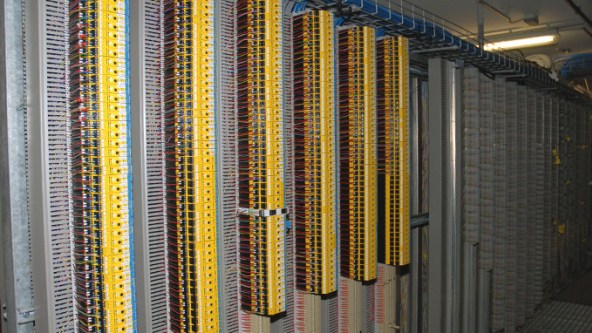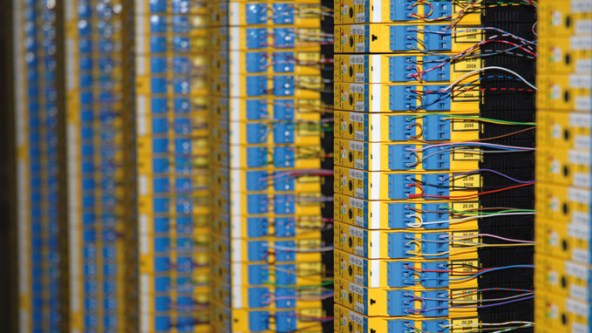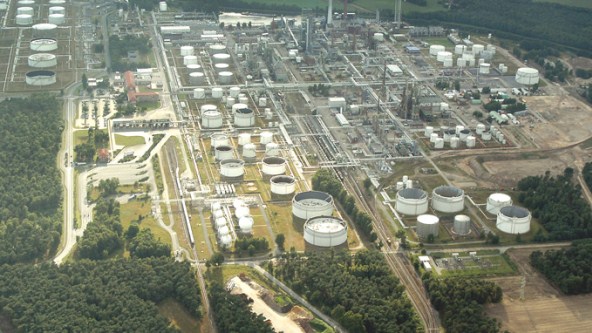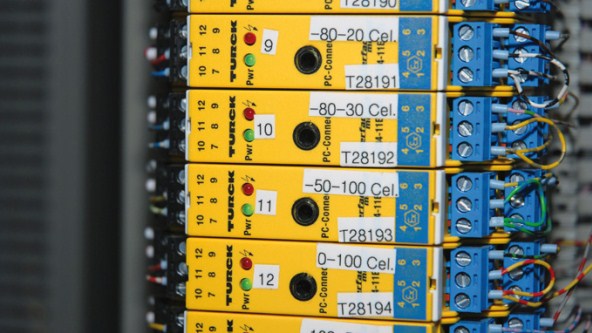Transductor de temperatura en carril DIN
La refinería de aceite BP Lingen moderniza la medición de la temperatura con el transductor de temperatura IM34 de Turck para el ensamblaje del carril DIN.
Cuando se trata de refinar aceite, la temperatura es uno de los más importantes parámetros del proceso. Es por eso que se han generado altas demandas para la medición de la temperatura con el fin de poder operar con más eficiencia las refinerías. En la refinería BP en Lingen, los especialistas en EMSR confían en los transductores de temperatura de Turck como parte de los esfuerzos dela compañía por modernizar la planta.
DIN rail replaces 19-inch technology
Temperature is one of the most important process parameters for refining crude oil. Replacing the temperature transducers installed in the 1980’s has been a topic at the BP refinery in Lingen, Germany. In contrast to the 19-inch transducers used during its time in the control room, in this project, BP Lingen is upgrading to modern interface devices for DIN rail assembly. “The 19-inch technology is disappearing from our plants more and more because a DIN rail solution in our case is simply more cost effective and the assembly time considerably lower,” says Nitschke. “When necessary, I can replace devices from different manufacturers without any problem – I simply remove the old device from the rail and place the new one on it, add voltage supply, signal input and output, and finished.”
Despite the many products to choose from, when replacing their 19-inch technology, the BP specialists intentionally selected the IM34 temperature transducer from Turck: “At that time, we looked at the products from leading suppliers and subsequently decided in favor of Turck,“ explains Holger Nitschke. “In addition to an excellent cost/benefit ratio, the compact design and the simple assembly were important for us because space in the control room is becoming increasingly expensive.”
Modernizing temperature measurement technology does not necessarily have to mean a completely new installation, as the example of the Lingen refinery shows. With the right technology, today’s requirements can be met by simply replacing the temperature transducer. “In the past, we performed many temperature measurements via type K thermocouples. That is why even in the older plants there is a high number of nickel-chromium/nickel cables between the control rooms and the plant. All of the existing wiring in the plant – including the sensors – can continue to be used,” explains Nitschke.
IM34 processes various input signals
In addition to thermocouples, Pt100 temperature sensors, based on the resistance change in platinum under the influence of temperature, are being increasingly used in process automation today. As a resistance thermometer for the temperature range of -200 to 500 °C, the Pt100 is more precise than a thermocouple. In contrast, the thermocouple, is suitable for a larger temperature range. Regardless of which measurement process is used, as a universal temperature transducer, the IM34 processes input signals from Ni100/Pt100 resistances, as well as thermocouples or millivolt signals. The device combines this universal capability with the high functionality of a freely parameterizable data logger and a PC interface for simple programming. The DTM (Device Type Manager) for the IM34 was developed in accordance to the current design guidelines of the FDT group.
- Automotriz
- Flexibilidad Modular y Seguridad en la Producción de Filtros
- El cable con control de corriente integrado evita paradas no deseadas del sistema de transporte
- Los acopladores inductivos garantizan una alimentación precisa del material
- Administración de ensamblaje con una conexión directa a MES
- Detección de carrocerías en la producción de automóviles.
- Detección confiable de derrape durante la producción de automóviles
- Recolección de pedidos JIS sin errores para los topes
- El modo de bus RFID garantiza la calidad de las baterías de iones de litio
- Medición de nivel en la línea de recubrimiento por inmersión
- El control de nivel en el sistema de lubricación centralizada
- El sensor de ángulo de inclinación acelera la alineación de la plataforma
- Control del motor con monitoreo de la condición
- El módulo híbrido IP67 procesa señales de seguridad
- Vigilancia descentralizada de estaciones refrigerantes
- Celdas de soldadura robotizadas en red con Ethernet
- Monitoreo del circuito de enfriamiento en abrazaderas de soldadura
- Monitoreo de flujo en lavadoras de tambos
- Innovación en el monitoreo de condiciones en los motores
- Monitoreo de nivel a través de la nube
- Taller de prensado - Identificación de herramientas
- Carrocería
- Pintura
- Ensamble Final
- Transmisiones y motores (powertrain)
- Detección a nivel de artículo con UHF RFID
- Suministro de refrigerante en máquinas
- Controla la presión hidráulica en las industrias de prensado.
- Medición de la presión del proceso en las plataformas
- HISTORIAS DE ÉXITO
- Soluciones RFID para la adquisición de datos de la producción en estatores
- Planta modular para una producción flexible y eficiente
- Sensor láser detecta los parachoques en la celda de ensamble
- Tecnología de seguridad descentralizada para una producción modular
- Sistema modular de bandas transportadoras
- Módulos E/S y RFID para cambios de herramienta de manera segura
- RFID en vehículos guiados automáticamente (AGV)
- Producción de silenciador de escape con Hubs IO-Link
- Identificación de pallets en la producción de ventilas traseras
- Detección de tuerca en el proceso de soldadura
- Rastreabilidad RFID
- RFID en la producción de motores
- Producción de defensas con identificación RFID
- Soluciones para el área de pintura
- Sensores para ensamblaje y soldadura
- Sensores de ángulo para sistemas de ensamble
- Identificación de Herramientas
- Productos únicos para bandas transportadoras
- RFID para área de carrocerías
- IO-Link facilita la producción de engranes diferenciales
- Química
- El sistema de E/S excom permite la licuefacción segura de hidrógeno
- Automatización descentralizada en zonas Ex
- Control RFID de las conexiones de los tubos en la zona Ex
- Conexión de señal Ethernet en la sala de I&C
- Automatización basada en Ethernet de los 'skids' modulares
- Aislamiento de áreas peligrosas en las industrias de procesos
- Detección de Pigs
- Señal de E/S Remota
- Conexión fácil de dispositivos de campo
- Procesamiento de señales con E/S del sistema en el gabinete de control
- Separación de señal con tecnología de interfaz en el gabinete de control
- Identificación de conexiones de manguera
- Monitoreo eficiente de gabinetes en el campo
- Monitoreo de los actuadores de cuarto de vuelta
- Planificación y montaje de soluciones de sistema
- Historias de Éxito
- Monitor del gabinete de control para la transmisión de datos de estado
- Refrigeración eficiente de hornos industriales con los sensores de flujo FS+ de Turck
- Sistema Excom de E/S genera espacio en las salas I & C
- Zona 2 y RFID 22
- Control de prueba eficiente
- Seguridad Intrínseca: Comunicación en campo
- Alianza en sistema de Control de Procesos
- E/S remotas para áreas peligrosas
- Comentarios de la válvula de doble posición
- Felxibilidad con buses de campo
- Manejo de activos con Entradas y Salidas remotas
- Posicionamiento correcto con RFID en Producción de Carbid
- Conversión rápida en un espacio limitado
- Energía
- Identificación por RFID en las bandas transportadoras de celdas solares
- Solución de E/S descentralizada en zona Ex para estación de servicio de H2
- El módulo de E/S facilita la configuración y el uso móvil del banco de pruebas de pilas de combustible
- Turbina con posicionamiento de rotación
- E/S IP67 en la producción de carbón
- RFID UHF Identifica Gabinetes Eléctricos
- E/S Remotas en Planta de Biogás
- Alimentos y Bebidas
- El sensor de monitoreo de condiciones automatiza el control del clima
- Monitoreo de las condiciones de los gabinetes de control
- Monitoreo de condiciones en almacenes
- Control del espesor de la masa en las máquinas de rodamiento
- Identificación de los contenedores de comida
- Reemplazo rápido del sensor en plantas de bebidas
- Detección de tuberías en codo
- Identificación de moldes de chocolates
- Historias de Éxito
- Mantenimiento basado en la nube para generadores de vapor
- El soporte RFID permite el seguimiento y la localización en la producción de alimentos
- Detección confiable de posición lineal en la zona Ex 22
- Módulos de control descentralizados en los cuartos fríos
- Seguimiento en la producción de carne con RFID
- Encoder sin contacto en la producción de papa
- UHF RFID en el centro de distribución de alimentos
- RFID para la producción del chocolate
- E/S distribuidas para equipos de alimentos
- E/S remotas para destilerías
- RFID y Autoclaves
- Transparencia en la fabricación del chocolate
- Fuentes de alimentación IP67 para Conveyors
- Identificación en el almacenamiento de productos alimenticios
- Logística
- Monitoreo de los Circuitos de Refrigeración y Lubricación en Máquinas CNC
- Prevención de atascos de paquetes en el centro logístico
- Control de altura y supervisión espacial 3D en montacargas autónomos
- Control descentralizado de módulos en la banda transportadora
- Rastreo de sacos grandes con RFID
- Detección de distancia en grúas de contenedores
- Control de acceso a zonas protegidas
- Sistema de silenciamiento descentralizado de equipos de protección electrosensible
- Bloques de E/S Módulos de transporte de rodillos de control
- Detección rápida de etiquetas en las compuertas en almacenes
- Detección a nivel de artículo con RFID UHF
- Mantenimiento Preventivo en Bandas Transportadoras
- Detección de contenedores de transporte
- Detección de nivel en recipientes
- Identificación en recipientes criogénicos
- Identificación de contenedores móviles con dispositivos handheld
- Identificación de los envases de alimentos
- Tier 1 - Identificación de choques
- Monitoreo de la condición en las salas de almacenamiento
- Protección contra colisiones en gruas 'reach stacker'
- Success Stories
- Solución eficiente para la digitalización de la tecnología de transportadores
- Logistics: RFID Reduces Error Quota by 99 Percent
- ROI Después de Tres Errores de Entrega Evitados.
- Rastreo sostenible de ITR gracias a RFID
- RFID con modo bus HF facilita el almacenamiento de semillas
- La tecnología RFID permite un almacén sin personal en una gran obra de construcción
- Los módulos de E/S y seguridad aumentan el rendimiento en la intralogística
- Rastreo de envíos de materias primas
- Solución de rastreo basada en RFID para minimizar los errores de carga
- Seguimiento de materiales entrantes y salientes mediante RFID
- Solución descentralizada RFID UHF
- Contact-free Encoder in Potato Production
- Módulos de control descentralizado en la cámara frìa
- Control de velocidad mediante el sensor de radar QT50
- Fuentes de alimentación IP67 para los transportadores
- Sistema de transporte modular
- Solución RFID para el almacén
- La RFID guía a los AGV en la producción en suspensión
- RFID identifica los productos farmacéuticos
- RFID UHF en el centro de distribución de alimentos
- Equipo Móvil
- Detección e identificación de animales y objetos en la cosechadora
- El sensor de control de estado automatiza la climatización
- Compensación automática en pendiente
- Líneas de distribución para pulverizadores de campo.
- Medición del ángulo en un pulverizador de campo
- Determinar el ángulo de posición de la plataforma de elevación
- Medición de inclinación de dos ejes en una cosechadora
- Protección contra colisiones en apiladores de alcance
- Historias de éxito
- Solución RFID con montacargas inteligentes en la producción automotriz
- Mantenimiento seguro a distancia de bombas de riego y drenaje
- Acceso controlado con sistema RFID
- Cosechador de espárragos selectivo
- Medición de posición con RFID y encoder
- Control de velocidad por medio de Sensor Radar QT50
- RFID Guía a AGV en la producción de suspensiones
- Modulos de E/S (TBEN) en yate de lujo
- Encoder sin desgaste en draga de tolva
- I/O para supresión de polvos
- Gabinete de enfriamiento
- Conectividad de desconexión rápida
- Soluciones de Automatización para frío extremo
- I/O remoto para grúas
- Elevador resistente de metales pesados
- Posicionamiento de montañas rusas
- Soluciones de maquinaria móvil
- Posición exacta de altura
- Detección de ángulo crítico
- Sensor de ángulo que detecta cuando se levanta la plataforma
- Petróleo y Gas
- Control Cabinet Guard protege los sistemas de TI de los ataques de los hackers
- Transductor de temperatura en carril DIN
- Sensores utilizados en plataformas marítimas con certificación ATEX
- Cableado de desconexión rápida para áreas peligrosas
- Los gabinetes de control compactos garantizan una alta seguridad de la información
- Embalaje
- Verificación descentralizada de paquetes de RFID
- Identificación de cartuchos de impresión a color
- Operación confiable de maquinaria
- Monitoreo de limites en líneas de llenado
- Supervisión de los procesos de cambio
- Identificación de botellas de prueba
- Monitoreo de nivel de café molido
- Detección de nivel en embarcaciones
- Detección de contenedores de transporte.
- HISTORIAS DE ÉXITO
- Farmacéutica y Biotecnología
- Seguimiento de muestras de principio a fin con RFID
- Control RFID de las conexiones de tubos en la zona Ex
- Verificación descentralizada de paquetes de productos farmacéuticos
- Automate Modular Skids
- Red de skids farmacéuticos con soluciones descentralizadas de E/S
- Aislamiento en plantas de proceso modulares
- Control de interfaces de válvulas
- Monitoreo de actuadores de cuarto de vuelta
- Detección de tubos en codo
- Señal remota de E/S
- Planeación y construcción de una estación de proceso
- Facil conexión de dispositivos de campo
- Identificación de recipientes criogénicos
- Identificación de contenedores móviles
- Identificación de contenedores móviles con dispositivos portátiles
- Identificación de conexiones de manguera para precursores
- Identificación de conexiones de tubo en áreas estériles
- Identificación de las conexiones de manguera en la zona Ex 1
- Identificación de bolsas grandes y biorreactores
- Identificación de aplicaciones de uso único
- HISTORIAS DE ÉXITO
- Comprobación de conexiones de mangueras con RFID.
- Transferencia sin contacto de energía y señales de conmutación
- Controles HMI en mezcladora industrial
- Máquina de procesamiento de imágenes controlada por el Gateway BL20
- RFID para identificar fármacos
- Medición de velocidad de cabezales mezcladores en agitadores magnéticos
- El dispositivo de lectura detecta diferentes materiales
- Semiconductor
Select Country
Turck worldwide











